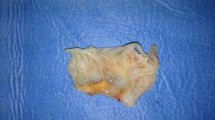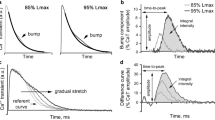Abstract
The report is a discussion of previously published and newly analyzed results concerning the association between heart diseases and alterations in the force-frequency relation (FFR). The optimum stimulation frequency of the FFR is measured and compared in isolated left ventricular myocardium from nonfailing hearts with atrial septal defect, coronary artery disease (without and with insulin dependent diabetes mellitus) and from failing hearts with mitral regurgitation, or idiopathic dilated cardiomyopathy. Specfically, we examine the role of alteredcontrol of the excitation-contraction coupling system in blunting the force-frequency relation. We use the percent slope of the FFR as a measure of changes in the frequency sensitivity of thiscontrol. Our finding of a linear, direct relation between optimum stimulation frequency and % slope across all disease types suggests both parameters are coupled to the same underlying mechanism. To investigate the possible role of alteredcontrol of the calcium pump in this mechanism, we analyzed the detailed relation between isometric twitch relaxation kinetics and stimulation frequency in mitral regurgitation myocardium (MR). In the presence of 0.5 μM forskolin the depressed slope and optimum frequency of the FFR and the prolonged half-time of twitch relaxation were all restored to values found in non-failing myocardium. We use the kinetics of isometric twitch relaxation as an index of changes in pumping rate that occur in response to changes in stimulation frequency or in intracellular cyclic adenosine monophosphate concentration. A mathematical model based on the Hill relations for calcium pump uptake rate and for isometric tension as a function of intracellular pCa is developed to simulate isometric twitch relaxation in MR and non-failing myocardium. The success of this model in simulating non-failing and failing twitch relaxation supports a proposed mechanism for the prolonged relaxation time and depressed FFR in MR involving depressed protein kinase-A activity (due to lowered cAMP or to a defect in the Ser16 site of phospholamban) as a mechanism of alteredcontrol of the calcium pump in MR heart disease.
Similar content being viewed by others
References
Bassani RA, Mattiazzi A, Bers DM (1995) CaMKII is responsible for activity-dependent acceleration of relaxation in rat ventricular myocytes. Am J Physiol 268: H703–12
Beuckelmann DJ, Nabauer M, Erdmann E (1992) Intracellular calcium handling in isolated ventricular myocytes from patients with terminal heart failure [see comments]. Circulation 85: 1046–1055
Blanchard EM, Mulieri LA, Alpert NR (1990) Dynamic calcium requirements for activation of rabbit papillary muscle calculated from tension-independent heat. Am J Cardiol 65: 8G-11G
Bohm M, Reiger B, Schwinger RH, Erdmann E (1994) cAMP concentrations, cAMP dependent protein kinase activity, and phospholamban in non-failing and failing myocardium. Cardiovasc Res 28: 1713–1719
Buckley NM, Penefsky ZJ, Litwak RS (1972) Comparative force-frequency relationships in human and other mammalian ventricular myocardium. Pflugers Arch 332: 259–270
Danielsen W, v. der Leyen H, Meyer W, Neumann J, Schmitz W, Scholz H, Starbatty J, Stein B, Doring V, Kalmar P (1989) Basal and isoprenaline-stimulated cAMP content in failing versus nonfailing human cardiac preparations. J Cardiovasc Pharmacol 14: 171–173
Eckberg DL, Gault JH, Bouchard RL, Karliner JS, Ross J Jr (1973) Mechanics of left ventricular contraction in chronic severe mitral regurgitation. Circulation 47: 1252–1259
Feldman MD, Copelas L, Gwathmey JK, Philips P, Warren SE, Schoen FJ, Grossman W, Morgan JP (1987) Deficient production of cyclic AMP: pharmacologic evidence of an important cause of contractile dysfunction in patients with end-stage heart failure. Circulation 75: 331–339
Feldman MD, Gwathmey JK, Philips P, Schoen F, Morgan JP (1988) Reversal of the force-frequency relationship in working myocardium from patients with end-stage heart failure. J Applied Cardiology 3: 273–283
Goldfine HL, Aurigemma GP, Gaasch WH (1992) Mechanism of reduction in ejection fraction following mitral valve replacement for mitral regurgitation. Circulation 86: I-660
Goldman ME, Mora F, Guarino T, Fuster V, Mindich BP (1987) Mitral valvuloplasty is superior to valve replacement for preservation of left ventricular function: an intraoperative two-dimensional echocardiographic study. J Am Coll Cardiol 10: 568–575
Gwathmey JK, Hajjar RJ (1990) Relation between steady-state force and intracellular [Ca2+] in intact human myocardium. Index of myofibrillar responsiveness to Ca2+. Circulation 82: 1266–1278
Gwathmey JK, Slawsky MT, Hajjar RJ, Briggs GM, Morgan JP (1990) Role of intracellular calcium handling in forceinterval relationships of human ventricular myocardium. J Clin Invest 85: 1599–1613
Hajjar RJ, Gwathmey JK, Briggs GM, Morgan JP (1988) Differential effect of DPI 201-106 on the sensitivity of the myofilaments to Ca2+ in intact and skinned trabeculae from control and myopathic human hearts. J Clin invest 82: 1578–1584
Hasenfuss G, Meyer M, Schillinger W, Pieske B, Scheffler A, Holubarsch C, Reinecke H (1994) Expression of sarcoplasmic reticulum proteins in failing and non-failing human myocardium. Circulation 90: I-216
Hasenfuss G, Mulieri LA, Blanchard EM, Holubarsch C, Leavitt BJ, Ittleman F, Alpert NR (1991) Energetics of isometric force development in control and volume-overload human myocardium. Comparison with animal species. Circ Res 68: 836–846
Hasenfuss G, Mulieri LA, Leavitt BJ, Allen PD, Haeberle JR, Alpert NR (1992) Alteration of contractile function and excitation-contraction coupling in dilated cardiomyopathy. Circ Res 70: 1225–1232
Hasenfuss G, Mulieri LA, Leavitt BJ, Alpert NR (1994) Influence of isoproterenol on contractile protein function, excitation-contraction coupling, and energy turnover of isolated nonfailing human myocardium. J Mol Cell Cardiol 26: 1461–1469
Hawkins C, Xu A, Narayanan N (1994) Sarcoplasmic reticulum calcium pump in cardiac and slow twitch skeletal muscle but not fast twitch skeletal muscle undergoes phosphorylation by endogenous and exogenous Ca2+/calmodulin-dependent protein kinase. Characterization of optimal conditions for calcium pump phosphorylation J Biol Chem 269: 31198–31206
Mattiazzi A, Hove-Madsen L, Bers DM (1994) Protein kinase inhibitors reduce SR Ca transport in permeabilized cardiac myocytes Am J Physiol 267: H812–20
Mulieri LA, Hasenfuss G, Ittleman F, Allen PD, Blanchard EM, Alpert NR (1989) Alterations in the force-fre-quency relation in stage III–IV failing human myocardium. Circulation 80: II-75
Mulieri LA, Hasenfuss G, Ittleman F, Blanchard EM, Alpert NR (1989) Protection of human left ventricular myocardium from cutting injury with 2,3-butanedione monoxime. Circ Res 65: 1441–1449
Mulieri LA, Hasenfuss G, Leavitt B, Allen PD, Alpert NR (1992) Altered myocardial force-frequency relation in human heart failure [see comments]. Circulation 85: 1743–1750
Mulieri LA, Ittleman FP, Leavitt BJ, Alpert NR (1992) Altered tension-frequency relation of human myocardium in volume overload heart failure. J Mol Cell Cardiol 24 (III): S44
Mulieri LA, Leavitt BJ, Hasenfuss G, Allen PD, Alpert NR (1992) Contraction frequency dependence of twitch and diastolic tension in human dilated cardiomyopathy (tension-frequency relation in cardiomyopathy). Basic Res Cardiol 87 Suppl 1: 199–212
Mulieri LA, Leavitt BJ, Ittleman FP, Martin BJ, Haeberle JR, Alpert NR (1992) Depressed myocardial force-frequency curve in mitral regurgitation heart failure is partially reversed by forskolin. Circulation 86: I-861
Mulieri LA, Leavitt BJ, Martin BJ, Haeberle JR, Alpert NR (1993) Myocardial force-frequency defect in mitral regurgitation heart failure is reversed by forskolin. Circulation 88: 2700–2704
Napolitano R, Vittone L, Mundina C, Chiappe de Cingolani G, Mattiazzi A (1992) Phosphorylation of phospholamban in the intact heart. A study on the physiological role of the Ca2+-calmodulin-dependent protein kinase system. J Mol Cell Cardiol 24: 387–396
Pagani ED, Alousi AA, Grant AM, Older TM, Dziuban SW, Jr Allen PD (1988) Changes in myofibrillar content and Mg-ATPase activity in ventricular tissues from patients with heart failure caused by coronary artery disease, cardiomyopathy, or mitral valve insufficiency. Circ Res 63: 380–385
Peters TJ, Wells G, Oakley CM, Brooksby IA, Jenkins BS, Webb-Peploe MM, Coltart DJ (1977) Enzymic analysis of endomyocardial biopsy specimens from patients with cardiomyopathies. Br Heart J 39: 1333–1339
Pieske B, Hasenfuss G, Holubarsch C, Schwinger R, Bohm M, Just H (1992) Alterations of the force-frequency relationship in the failing human heart depend on the underlying cardiac disease. Basic Res Cardiol 87, Suppl 1: 213–221
Pieske B, Kretschmann B, Schmidt-Schweda S, Minami K, Posival H, Just H, Hasenfuss G (1993) Alterations in intracellular calcium handling are a major cause for the inverse force-frequency relationship in the failing human myocardium. Circulation 88: I-373
Pieske B, Trost S, Sutterlin M, Posival H, Minami K, Hasenfuss G (1994) Influence of forskolin on the force-frequency relationship in human nonfailing and end-stage failing myocardium. Circulation 90: I-211
Schmidt U, Schwinger RH, Bohm M (1995) Halothane restores the altered force-frequency relationship in failing human myocardium. Anesthesiology 82: 1456–1462
Schouten VJ (1990) Interval dependence of force and twitch duration in rat heart explained by Ca2+ pump inactivation in sarcoplasmic reticulum. J Physiol (Lond) 431: 427–444
Schwinger RH, Bohm M, Erdmann E (1992) Inotropic and lusitropic dysfunction in myocardium from patients with dilated cardiomyopathy Am Heart J 123: 116–128
Schwinger RH, Bohm M, Muller-Ehmsen J, Uhlmann R, Schmidt U, Stablein A, Uberfuhr P, Kreuzer E, Reichart B, Eissner HJ (1993) Effect of inotropic stimulation on the negative force-frequency relationship in the failing human heart. Circulation 88: 2267–2276
Talosi L, Edes I, Kranias EG (1993) Intracellular mechanisms mediating reversal of beta-adrenergic stimulation in intact beating hearts. Am J Physiol 264: H791–7
Toyofuku T, Curotto Kurzydlowski K, Narayanan N, MacLennan DH (1994) Identification of Ser38 as the site in cardiac sarcoplasmic reticulum Ca2+-ATPase that is phosphorylated by Ca2+/calmodulin-dependent protein kinase. J Biol Chem 269: 26492–26496
Voss J, Jones LR, Thomas DD (1994) The physical mechanism of calcium pump regulation in the heart [see comments]. Biophys J 67: 190–196
Xu A, Hawkins C, Narayanan N (1993) Phosphorylation and activation of the Ca2+-pumping ATPase of cardiac sarcoplasmic reticulum by Ca2+/calmodulin-dependent protein kinase. J Biol Chem 268: 8394–8397
Author information
Authors and Affiliations
Rights and permissions
About this article
Cite this article
Mulieri, L.A., Leavitt, B.J., Wright, R.K. et al. Role of cAMP in modulating relaxation kinetics and the force-frequency relation in mitral regurgitation heart failure. Basic Res Cardiol 92 (Suppl 1), 95–103 (1997). https://doi.org/10.1007/BF00794073
Issue Date:
DOI: https://doi.org/10.1007/BF00794073




